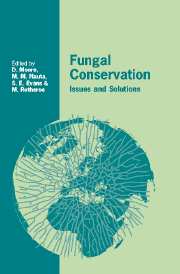Book contents
- Frontmatter
- Contents
- List of contributors
- Preface
- 1 Fungal conservation issues: recognising the problem, finding solutions
- 2 Current trends and perspectives for the global conservation of fungi
- 3 Conservation and management of forest fungi in the Pacific Northwestern United States: an integrated ecosystem approach
- 4 The future of fungi in Europe: threats, conservation and management
- 5 Fungi as indicators of primeval and old-growth forests deserving protection
- 6 Recognising and managing mycologically valuable sites in The Netherlands
- 7 Threats to hypogeous fungi
- 8 Wild mushrooms and rural economies
- 9 Threats to biodiversity caused by traditional mushroom cultivation technology in China
- 10 A preliminary survey of waxcap grassland indicator species in South Wales
- 11 Grasslands in the coastal dunes: the effect of nature management on the mycota
- 12 The conservation of fungi on reserves managed by the Royal Society for the Protection of Birds (RSPB)
- 13 Strategies for conservation of fungi in the Madonie Park, North Sicily
- 14 Fungal conservation in Ukraine
- 15 The threatened and near-threatened Aphyllophorales of Finland
- 16 Fungal conservation in Cuba
- 17 Microfungus diversity and the conservation agenda in Kenya
- 18 Fungi and the UK Biodiversity Action Plan: the process explained
- 19 The Scottish Wild Mushroom Forum
- 20 The contribution of national mycological societies: establishing a British Mycological Society policy
- 21 The contribution of national mycological societies: the Dutch Mycological Society and its Committee for Fungi and Nature Conservation
- 22 Fungal conservation in the 21st century: optimism and pessimism for the future
- Index
2 - Current trends and perspectives for the global conservation of fungi
Published online by Cambridge University Press: 13 October 2009
- Frontmatter
- Contents
- List of contributors
- Preface
- 1 Fungal conservation issues: recognising the problem, finding solutions
- 2 Current trends and perspectives for the global conservation of fungi
- 3 Conservation and management of forest fungi in the Pacific Northwestern United States: an integrated ecosystem approach
- 4 The future of fungi in Europe: threats, conservation and management
- 5 Fungi as indicators of primeval and old-growth forests deserving protection
- 6 Recognising and managing mycologically valuable sites in The Netherlands
- 7 Threats to hypogeous fungi
- 8 Wild mushrooms and rural economies
- 9 Threats to biodiversity caused by traditional mushroom cultivation technology in China
- 10 A preliminary survey of waxcap grassland indicator species in South Wales
- 11 Grasslands in the coastal dunes: the effect of nature management on the mycota
- 12 The conservation of fungi on reserves managed by the Royal Society for the Protection of Birds (RSPB)
- 13 Strategies for conservation of fungi in the Madonie Park, North Sicily
- 14 Fungal conservation in Ukraine
- 15 The threatened and near-threatened Aphyllophorales of Finland
- 16 Fungal conservation in Cuba
- 17 Microfungus diversity and the conservation agenda in Kenya
- 18 Fungi and the UK Biodiversity Action Plan: the process explained
- 19 The Scottish Wild Mushroom Forum
- 20 The contribution of national mycological societies: establishing a British Mycological Society policy
- 21 The contribution of national mycological societies: the Dutch Mycological Society and its Committee for Fungi and Nature Conservation
- 22 Fungal conservation in the 21st century: optimism and pessimism for the future
- Index
Summary
Introduction
For rather more than a year, the specialist group for fungi within the Species Survival Commission (SSC) of the International Union for the Conservation of Nature (IUCN) has been revived after interruption in its activities between 1995 and 1998. As a member of the European Council for the Conservation of Fungi (ECCF) standing committee, I shared with my ECCF colleagues the regret that fungi were no longer taken into account within the IUCN. So we decided to take advantage of the June 1998 Planta Europa meeting, in Uppsala, to establish new contacts with the IUCN and to revive this specialist group.
Within the new specialist group for fungi, the ECCF serves as the main framework since it has accumulated much data and experience on the topic since 1984. But I am also trying to federate further mycologists involved in conservation outside Europe so that the group will consist of a genuinely enlarged and international network.
In this chapter I will give a brief description of the present global state of knowledge concerning fungal conservation and indicate the main priorities we should consider for the future. Of course, this owes a great deal to the ECCF heritage, especially through the decisive contributions from some of its members, such as Eef Arnolds and others. I also received feedback from some members of the new group but I do not claim that the literature survey is in any way exhaustive and I do realise that some points may not be represented here.
- Type
- Chapter
- Information
- Fungal ConservationIssues and Solutions, pp. 7 - 18Publisher: Cambridge University PressPrint publication year: 2001
- 12
- Cited by



